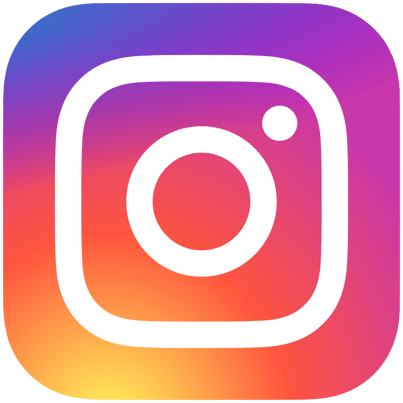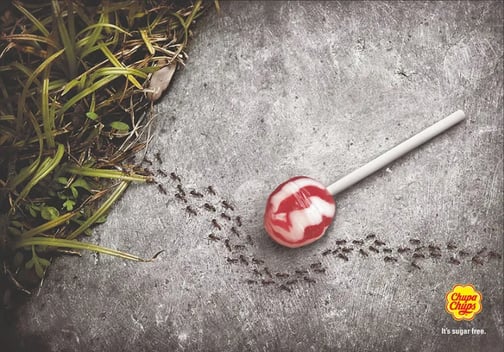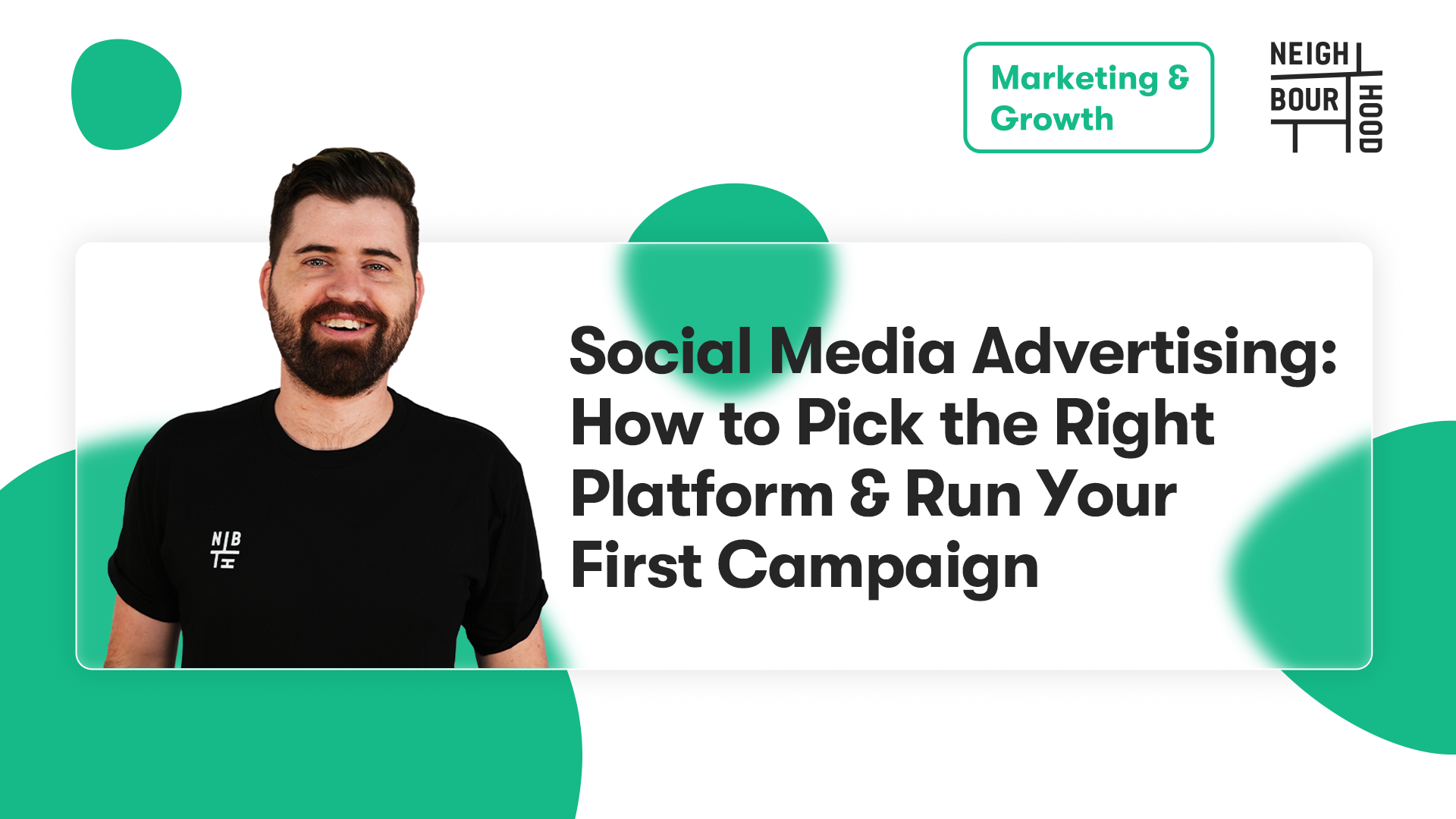According to a recent survey, 82% of consumers now consult their phones before buying absolutely anything. It's clear that to get your name out there, you need to target customers on the device where they are most receptive to your message. Where better to do this than through the social media that keeps us glued to our phones all day?
Unfortunately, Social media is a saturated marketing landscape. So how do you cut through the clutter and end up in the right feed at the right time? Social media advertising, of course!
But you might be asking, what is social media advertising? How much does it cost? What social media channels should I even choose for my brand?
Today I'll give you a complete guide on social media advertising to answer these FAQs and more. I'll also provide tips on creating effective strategies for your social media campaigns, including how to maximise your advertising budget.
What Is Social Media Advertising?
Social media advertising is a branch of digital marketing that involves delivering paid ads to your target audiences using social networks like Instagram, Facebook, and Twitter. It can be a quick and cost-effective way to reach new prospects while enhancing your brand's awareness among your existing customers.
A well-planned social media campaign can also enable businesses to generate more sales with minimal effort. Research shows that approximately 26% of Facebook users who click on ads make purchases.
With consumers increasingly turning to the internet to compare products and make purchasing decisions, it's become critical for every business to have a solid online presence. The more your clients can spot your organisation online, the more likely they will identify with your goods and services. That explains why a survey of CMOs showed that businesses plan to double their social media advertising budgets by next year.
And that's where the problem lies — as everybody tries to ensure their brand has a solid social media presence, it's no longer easy to stand out and get your target audience's attention.

Fortunately, social media advertising comes with sophisticated targeting capabilities.
Traditional marketing channels use the carpet-bombing technique, where businesses broadcast ads to as many people as possible. In comparison, social media advertising involves delivering optimised ads to ideal prospects with specific behavioural, geographic, psychographic, or demographic traits. A business dealing in men's shoes can choose to deliver their social media advertisements to men only and even target consumers who have shown interest in shoes and is more likely to purchase.
The Main Components of Social Media Advertising
To understand how social media marketing works, you first need to understand the five key components of social media advertising:
1. Target Audience
It is important to understand who is most likely to engage with your brand so you can be as specific as possible when selecting a campaign's target audience. Before placing an ad, review your social media platforms to identify your clients' interests, characteristics and traits.
Target audience selection is inarguably the most crucial part of social media advertising. If you do it well, you're likely to narrow down on an audience that relates to your ads and have an interest in your products, increasing your returns on investment. Comparatively, if you mess up at this stage, you're likely to target the wrong demographic with zero interest in your products, causing the campaign to fail even before it begins.
2. Campaign Budget and Key Performance Indicators
A lot of people will only focus on the budget and forget success metrics. However, the two are inseparable. Your campaign budget should never exceed the returns that you expect to get back from an investment. For example, if you're targeting 100 sales of products that cost $2 each, your marketing expenses should always be less than $200.
3. Campaign Creatives
A social media campaign can use images, videos, GIFs, and creative copy to deliver the brand's message to the target audience. Ensure these match your customer's preferences and the platform's guidelines. For instance, when targeting kids, it will be more effective to use colourful visuals that can get their attention than big chunks of text.
4. Campaign Overview
An overview outlines elementary details about the campaign, such as its purpose, name, hashtags, and inspiration. It can also highlight how the initiative will help you achieve your business needs. Quantify your objectives to make it easy to track performance.
5. Social Media Platforms
Different social media platforms offer access to varying demographics. For instance, if your business targets teens or sells fast-moving consumer goods, it might be better to place your social media ads on Instagram or TikTok. Selecting the right social channels can also help you decide the content formats, messaging approach, and budget.
Types of Social Media Advertising Platforms
Different social platforms serve varying demographics of social media users and are suitable for different social media ads. Here's an overview of the five most popular:
.png?width=357&height=357&name=800px-Facebook_logo_(square).png)
Facebook is arguably the most popular social media advertising medium today. Let's go over some of its key factors to help you decide if the platform suits your marketing needs:
Active Facebook Users
According to the latest data from Facebook's parent company, Meta, the platform has over 2.96 billion active users globally. In Australia, it has over 13 million users, 9 million of which use it daily. Over 60% of these users discover products on the platform, visit advertisers' websites, or research more about the product on Facebook. Out of these, 35% share and discuss their discoveries with peers. By any standard, this figure is too big to ignore.
Demographics
While the network is popular among all age groups, most Australian users are millennials, students, and mums. Recent research by Meta shows that 2 out of 3 Australian mums and over 80% of 16-24-year-olds access the platform daily. So, if you want to target men above 30 years, this network might not be ideal.
Devices
Meta's data shows that the majority of Facebook's users access the platform through their mobile phones. The number of active users peaks between 2 pm and 5 pm and then steadily reduces until after 8 pm. Statistics also show that over 50% of Australians watch videos on the platform. Therefore, if you want to achieve the highest returns on investment from Facebook ads, create video content and post them between 2 pm and 5 pm.
Ad Costs and Revenue
Facebook charges an average of $12.07 per 1,000 impressions and $0.94 per click, making it cheaper than YouTube, Instagram, and LinkedIn. In other words, you can pay $0.94 for every user who clicks on your ad or $12.07 for every 1,000 people who interact (like, share or view) your ads. Cost per click (CPC) is ideal for advertisers who target direct sales or site visits, while cost per mile/1,000 impressions (CPM) is perfect for those seeking to enhance brand awareness.
Meta currently makes over $82.4 billion annually from Facebook ads, showing that businesses are investing a lot in this medium. While the increase in the platform's advertisers might be intimidating, it shows that advertisers trust the platform as it promises impressive returns.
Supported Formats
Facebook offers comprehensive digital marketing packages that support the following formats:
-
- Videos: With over half of Australians watching videos on Facebook daily, this format promises the best return on investment. The platform allows businesses to promote ads up to 4 hours long. However, shorter ads often perform better.
-
- Images: Your business can promote its products and drive engagement through still photos. The platform allows adding up to 10 pictures per ad.
Common Types of Facebook Ads
Depending on your target audience and marketing objectives, you can run the following Facebook ads:
-
- Collection: These ads feature one primary video or image and four other photos in a grid format under the primary media. When users click on them, the platform automatically redirects them to the product's landing page without leaving the app.
-
- Engagement posts: If you want to enhance brand awareness, these ads are your best shot. They typically boost your posts to enable them to get more views, comments, likes, and shares.
-
- Slideshow: These allow advertisers to create slideshow videos by adding motion, sound, and text to still photos. You can make these directly in Facebook Ad Manager by selecting the images you want to use, generating a slideshow and then simpling posting it as an ad.
-
- Carousel: This ad involves adding up to 10 videos or images in one ad, with each video or image comprising links to different products or pages.
-
- Lead generation ads: These ads enable organisations to gather information from users who may be interested in their products. This data can be used to create email marketing campaigns, to provide sales teams with interested leads or to help you create more relevant campaign materials.
-
- Event responses: Are you planning an event? You can create an ad to invite attendees and boost RSVPs.
-
- Offers: Businesses can also run Facebook ads to inform their clients about existing discounts.
-
- Instant experience: These mobile-exclusive ads allow mobile users to interact with the ad content. They can hold up to 20 videos or images but should be at most two minutes.

Instagram and Facebook belong to the same parent company, Meta, and offer similar ads. There are, however, some differences. Here's what you need to consider before placing an advertisement on the platform:
Active Users
According to Statista, Instagram has over a billion active monthly users. Approximately 31% of these users are 25 to 34 years old, with over two-thirds being below age 35. In Australia, over 13 million people use the network, accounting for almost 51% of the country's total population.
Demographic
SMPERTH estimates that approximately 52.2% of Instagram users are females. The slight difference between the number of the platform's male and female users makes it ideal for social media ads targeting both genders. Regarding location, 46% of the network's users stay in urban areas, 35% in suburban areas, and 21% in rural areas.
Devices
Like Facebook, most of Instagram's users access the platform through mobile phones, with over 25% of smartphone users having the app. According to the Search Engine Journal, the best times to post ads on the app are between 7 am and 8 am and between 11 pm and 1 pm.
Ads Cost and Revenue
Instagram ads cost an average of $0.20 and $6.70, depending on the model you're using. If you opt for cost-per-click adverts, you'll pay $0.20 to $2 per click. For cost-per-impressions, you'll spend about $6.70 for every 1,000 impressions. The annual Instagram ad revenue is steadily increasing, from $17.4 billion in 2020 to over $33.3 billion in 2022, showing a continuous increase in the app's digital marketing offers.
Supported Formats
Like Facebook, Instagram supports ads, images, videos, and text formats. You can also use customised show-reels comprising several images with texts and accompanying music.
Common Types Of Instagram Ads
As Instagram and Facebook offer similar ads, I'll try to avoid too much repetition, but here are a few examples:
-
- Photo ads
- Stories ads
- Carousel ads
- Video ads
- Collection ads

The platform has over 365 million active monthly users. Australia accounts for 5.8 million of the app's users, of which almost 70% are men and 42% have a college education. Additionally, 85% of Twitter's users earn over $30,000 USD per annum. This makes it ideal for brands targeting well-educated men with stable incomes.
There is currently a wide variety of Twitter Ads on offer:
-
- App engagements
- Brand awareness
- Promoted hashtags or trends
- Tweet engagement
- App installs
- Website clicks
- Promoted videos
- In-stream video views
Charges can vary depending on an advertiser's preferred model. For instance, promoted trends cost approximately $200,000 per day while, at the opposite end of the spectrum, tweet engagements cost $1.35 per reply, retweet, or click.

Of the platform's 875 million users, 56.4% are male. Unlike Facebook and Instagram, the platform is more business-oriented. Its targeting criteria revolve around job title, education, industry, and business size. It has three types of advertising offers:
-
- Sponsored ads: These ads appear in your target audiences' LinkedIn feeds. They're perfect for brand awareness promotion, lead generation, and conversion.
- InMail: This feature allows users to send 5 to 30 emails to target audiences. It's only available to Premium users. For every response you get, LinkedIn awards you one InMail credit.
- Sponsored InMail: Unlike InMails, these mails go directly to recipients' inboxes. You can use them to increase engagement and sales.
TikTok

One of the newest social media platforms, TikTok, has taken the world by storm boasting 689 million users worldwide. One of the most important demographic factors of the user base is that 47% of TikTok users are between ages 10-29, making it perfect for targeting younger Gen Z and Millenial consumers. TikTok offers six types of ads.
-
- In-feed Ads: These are the ads that appear as you scroll through the "For-You-Page" (FYP). They contain a call-to-action (CTA) button that links to a landing page or website and can be great for driving sales.
- Spark Ads: Created from existing content on a TikTok user, this ad type allows the user to boost that content and make it more likely to appear on relevant FYPs. They link back to the account itself and not an external link meaning they appear more organic and are great for promoting a brand account.
- TopView Ads: These are the first thing a user sees when opening the TikTok app and consist of a video that auto-plays in full screen. While they can appear less organic than other ads, they are definitely attention-grabbing and allow for a CTA button to an external link.
- Brand Takeover Ads: Similar to Topview ads, these appear when a user first opens the app. They consist of much shorter (3-5 second) videos or image sets; each user will only see one per day. They can be great for driving exposure for one-off events or sales.
- Branded Hashtag Challenge Ads: This ad type is designed to inspire user-generated content. Sponsoring a hashtag makes it more likely to appear on the FYP, meaning content generators are likely to create content around that hashtag. By pushing users to generate content, it can lead to a much more organic feeling advertising campaign which is perfect for building awareness and engagement.
- Branded Effect Ads: These are filters or special effects that feature a company's branding. Like branded hashtags, they also encourage user-generated content as they can be quite attention-grabbing. Branded effects are perfect for brands looking to create exposure and communicate their brand identity.
Which Social Media Platform Has the Most Effective Advertising?
Facebook is the most popular social media platform for marketers. However, this doesn't mean it will always deliver the best results for you!
Before deciding the platform to use, consider the following factors:
Your Target Audience
The audience is inarguably the most crucial determinant of the ideal platform. The rule of thumb is always to go with the network most of your target audiences use. For example, while Facebook has the largest number of active users, it might not have as many teenage users as Instagram and TikTok. Therefore, these platforms would be better for targeting these consumers.
Your Products and Services
Which goods or services do you sell? Do you want your products to come out as formal or casual? Your products, business type, and personality also play a significant role in helping you decide on the best platform. For instance, if you're a highly visual brand, like an actor or designer, it might be more appropriate to use Instagram, DeviantArt, and Dayflash. Comparatively, B2B companies are more likely to derive better results through LinkedIn.
Your Competitors
Before you start your campaign, why not see what's working for everyone else? Consider the platforms your competitors are using and whether they work for them. Competitor research can help you emulate the success of others in the market while avoiding making the same mistakes.
Your Marketing Goals
Social media is not a one-size-fits-all. Before starting, you need to know what you wish to achieve, or your campaigns may not be effective. If your main aim is to offer customer support, Twitter and Facebook should be your first options. Comparatively, if your primary target is to enhance brand awareness, Instagram may be the better choice.
What Type of Content Is Best for Social Media Advertising?
The best ad type depends on your marketing objectives, target audience, and preferred platform. Below are a few common examples:
Static Image Ads

Social media users tend to be drawn more to visuals than texts. Because of this, photos are a perfect way to catch the target audience's attention and appealingly communicate your message. Most platforms support adding "Shop Now" buttons on photos to redirect users to checkout or product landing pages. If you decide to use this format, ensure the static image is high quality and consistent with the accompanying message.
Video Ads

Videos are often more visually appealing than static images. Platforms like Instagram, Facebook and TikTok allow businesses to upload or create in-app videos that social media users can view as they navigate their feeds. For the best results, use short videos.
Stories Ads
Social media networks like Instagram, Twitter, LinkedIn and Facebook allow users to share Stories-ads comprising videos and photos. These ads typically disappear after 24 hours and often cost less than standard social media posts. Users will view a photo for six seconds if you add a photo to your Facebook story ad. Comparatively, Instagram Stories ads can last up to 120 seconds.
Messenger Ads
These ads involve sending direct messages to Facebook users. You can use them to answer customer questions, initiate conversations with potential customers or redirect prospects to your websites.
Some Final Tips for Creating an Effective Social Media Marketing Strategy
Now you know a bit more about the major social media channels and how to choose the best one for you, you might be wondering how to ensure campaign success. The following tips can help you make your social media advertising campaigns more effective:
- Start by analysing what already works: Before investing in social media ads, start by determining what content will actually resonate with your customers. This can be done by focusing on leads that have already shown interest in your organic content.
- Focus on your audience's needs: We cannot underscore the importance of prioritising value for your target audience enough. If clients find your content relatable, you can get their attention quickly.
- Create engaging content: Use graphics, videos, images, and social media posts to create exciting content that can inspire likes, comments, and shares from your target audience. Social media networks typically favour users and posts with high engagement.
And that's it, everything you need to know to get started in Social Media Advertising. You're ready to get out there and get your products and services on the right screens to ensure attention from your ideal customers.
But, of course, starting any new advertising campaign can be a time-consuming process. So you might need to call in the professionals to get the most out of your social media advertising efforts!




